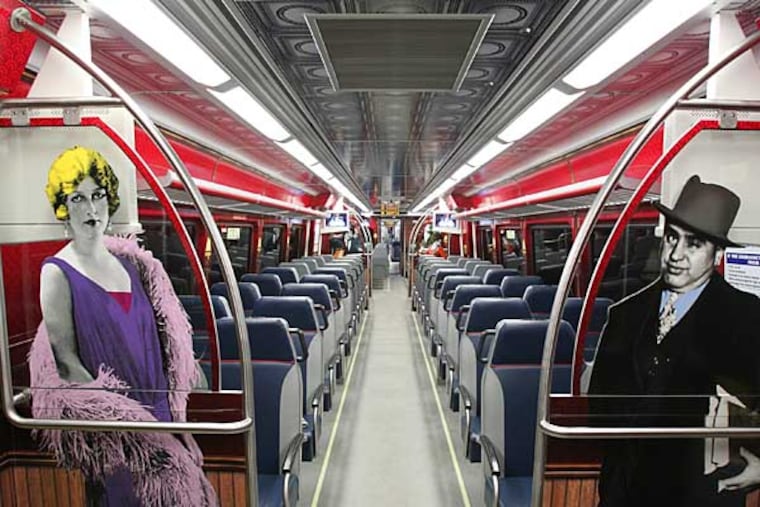SEPTA's trains all wrapped up, ready to roll
Forget about taking the 10:25 to Doylestown. Now you're hopping on the "Sunshine Express." Four SEPTA train cars have been converted into rolling advertisements for Tropicana juice, covered inside and out in a wake-up orange hue, as part of an aggressive effort by SEPTA to sell ad space on its vehicles and stations.

Forget about taking the 10:25 to Doylestown.
Now you're hopping on the "Sunshine Express."
Four SEPTA train cars have been converted into rolling advertisements for Tropicana juice, covered inside and out in a wake-up orange hue, as part of an aggressive effort by SEPTA to sell ad space on its vehicles and stations.
An additional 21 cars are wrapped in ads for Bailey's Irish Cream, and Market East Station is filled with Honda ads plastered on pillars, walls, and windows, aimed at riders who were headed to this month's Philadelphia Auto Show.
SEPTA will make about $14 million this year from Tropicana, Bailey's, Honda, AT&T and other advertisers, up from $11 million last year and $7.5 million in 2005, said Richard Burnfield, chief financial officer for SEPTA.
Transit agencies around the region and the nation have moved far beyond traditional bus and subway placards as they look to boost revenue in tight financial times.
They are wrapping vehicle exteriors and making over interiors to tout products, companies and even local museum exhibitions: SEPTA train 702 looks like a rolling speakeasy, decorated inside with a faux tin ceiling, phony wallpaper, mock lamps, and images of flappers, mobsters, musicians and a bartender to promote the Prohibition exhibit at the National Constitution Center.
In 2010, SEPTA got $3.4 million over five years to change the name of its Pattison Station on the Broad Street subway line to AT&T Station. More station renamings may be in the works.
"I'm open to anything," Burnfield said. "If we could put a sticker on you, we would."
Well, not quite anything.
SEPTA won't take ads for tobacco products. And in 2007, community protests prompted the transit agency to remove advertising wraps on two buses for Colt 45 malt liquor.
Anything deemed too violent or sexually provocative won't roll in Philadelphia. For example, a local cheesesteak emporium was not allowed to promote itself with an ad featuring a scantily clad female model hugging a hoagie roll.
SEPTA and New York-based advertising company Titan Outdoor L.L.C. have taken advantage of new laws and new technology to change the way they pitch ads to customers.
A Pennsylvania law was changed in 2011 to permit rail cars to be wrapped with advertising, and digital TV screens in 120 new Silverliner V rail cars now allow local advertisers to target customers in specific geographic areas. A Main Line furniture company, for instance, can limit its ads to trains running on the Paoli/Thorndale line.
To print and install the vinyl advertising wrap inside and outside a rail car costs about $35,000, said Jon Roche, Titan's general manager for the Philadelphia area. And the cost of advertising on a fully wrapped car is about $20,000 per month.
It takes workers three days to wrap each car, Roche said. The wrap then stays on for an average of three months, depending on the client's contract.
SEPTA gets 62.5 percent of the money from advertisers, while Titan gets 37.5 percent, a typical split in the industry.
Andy Sharpe of the Delaware Valley Association of Rail Passengers said the billboards-on-rails demonstrate to legislators that "SEPTA is serious about identifying innovative sources of funding, which lends credibility every time they ask for state or federal money."
The passengers' organization is somewhat concerned about ads covering train windows, Sharpe said. The translucent vinyl sheets obscure the view, which Sharpe said could be a problem for riders trying to spot their stop.
Other transit agencies in the region also contract with Titan to sell advertising on vehicles, platforms, stations and trestles, as well as on their websites.
At PATCO, the commuter line between Philadelphia and South Jersey, six car interiors are wrapped with ads for the University of Pennsylvania Medicine's Proton Therapy Center, and two exteriors are wrapped with ads for AmeriHealth.
PATCO has collected $2.6 million from the car wraps and other advertising since 2008, deputy general manager Cheryl Spicer said.
NJ Transit made $11.1 million from its advertising in fiscal 2012, spokesman John Durso said. From fiscal 2004, when the agency began placing exterior ads on buses (trains began in 2009), through last March, NJ Transit collected $73.3 million for advertising.
The advertising money helps "to keep fares stable and improve the travel experience for our customers while helping NJ Transit further reduce reliance on taxpayer subsidies," Durso said.